Dong Du
HUNYUANPROVER: A Scalable Data Synthesis Framework and Guided Tree Search for Automated Theorem Proving
Dec 30, 2024Abstract:We introduce HunyuanProver, an language model finetuned from the Hunyuan 7B for interactive automatic theorem proving with LEAN4. To alleviate the data sparsity issue, we design a scalable framework to iterative synthesize data with low cost. Besides, guided tree search algorithms are designed to enable effective ``system 2 thinking`` of the prover. HunyuanProver achieves state-of-the-art (SOTA) performances on major benchmarks. Specifically, it achieves a pass of 68.4% on the miniF2F-test compared to 65.9%, the current SOTA results. It proves 4 IMO statements (imo_1960_p2, imo_1962_p2}, imo_1964_p2 and imo_1983_p6) in miniF2F-test. To benefit the community, we will open-source a dataset of 30k synthesized instances, where each instance contains the original question in natural language, the converted statement by autoformalization, and the proof by HunyuanProver.
Hunyuan-Large: An Open-Source MoE Model with 52 Billion Activated Parameters by Tencent
Nov 05, 2024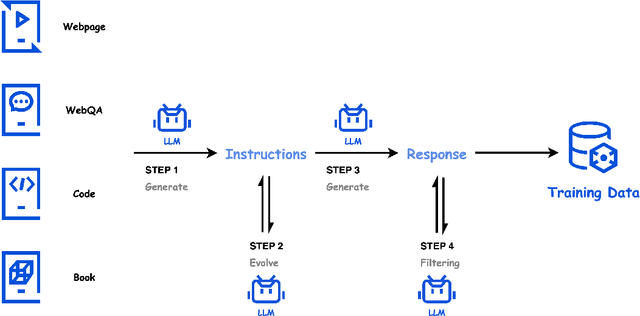
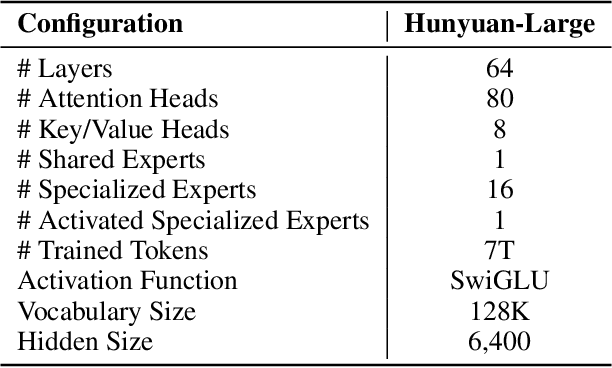
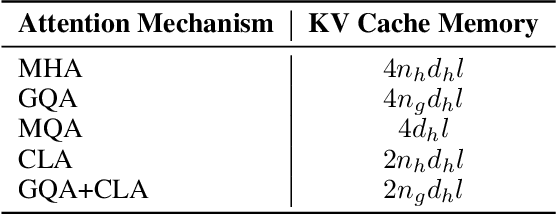
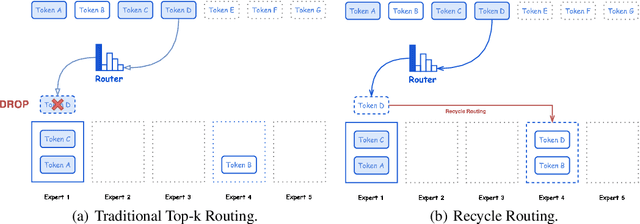
Abstract:In this paper, we introduce Hunyuan-Large, which is currently the largest open-source Transformer-based mixture of experts model, with a total of 389 billion parameters and 52 billion activation parameters, capable of handling up to 256K tokens. We conduct a thorough evaluation of Hunyuan-Large's superior performance across various benchmarks including language understanding and generation, logical reasoning, mathematical problem-solving, coding, long-context, and aggregated tasks, where it outperforms LLama3.1-70B and exhibits comparable performance when compared to the significantly larger LLama3.1-405B model. Key practice of Hunyuan-Large include large-scale synthetic data that is orders larger than in previous literature, a mixed expert routing strategy, a key-value cache compression technique, and an expert-specific learning rate strategy. Additionally, we also investigate the scaling laws and learning rate schedule of mixture of experts models, providing valuable insights and guidances for future model development and optimization. The code and checkpoints of Hunyuan-Large are released to facilitate future innovations and applications. Codes: https://github.com/Tencent/Hunyuan-Large Models: https://huggingface.co/tencent/Tencent-Hunyuan-Large
SketchMetaFace: A Learning-based Sketching Interface for High-fidelity 3D Character Face Modeling
Jul 04, 2023



Abstract:Modeling 3D avatars benefits various application scenarios such as AR/VR, gaming, and filming. Character faces contribute significant diversity and vividity as a vital component of avatars. However, building 3D character face models usually requires a heavy workload with commercial tools, even for experienced artists. Various existing sketch-based tools fail to support amateurs in modeling diverse facial shapes and rich geometric details. In this paper, we present SketchMetaFace - a sketching system targeting amateur users to model high-fidelity 3D faces in minutes. We carefully design both the user interface and the underlying algorithm. First, curvature-aware strokes are adopted to better support the controllability of carving facial details. Second, considering the key problem of mapping a 2D sketch map to a 3D model, we develop a novel learning-based method termed "Implicit and Depth Guided Mesh Modeling" (IDGMM). It fuses the advantages of mesh, implicit, and depth representations to achieve high-quality results with high efficiency. In addition, to further support usability, we present a coarse-to-fine 2D sketching interface design and a data-driven stroke suggestion tool. User studies demonstrate the superiority of our system over existing modeling tools in terms of the ease to use and visual quality of results. Experimental analyses also show that IDGMM reaches a better trade-off between accuracy and efficiency. SketchMetaFace is available at https://zhongjinluo.github.io/SketchMetaFace/.
3D Keypoint Estimation Using Implicit Representation Learning
Jun 20, 2023Abstract:In this paper, we tackle the challenging problem of 3D keypoint estimation of general objects using a novel implicit representation. Previous works have demonstrated promising results for keypoint prediction through direct coordinate regression or heatmap-based inference. However, these methods are commonly studied for specific subjects, such as human bodies and faces, which possess fixed keypoint structures. They also suffer in several practical scenarios where explicit or complete geometry is not given, including images and partial point clouds. Inspired by the recent success of advanced implicit representation in reconstruction tasks, we explore the idea of using an implicit field to represent keypoints. Specifically, our key idea is employing spheres to represent 3D keypoints, thereby enabling the learnability of the corresponding signed distance field. Explicit keypoints can be extracted subsequently by our algorithm based on the Hough transform. Quantitative and qualitative evaluations also show the superiority of our representation in terms of prediction accuracy.
NerVE: Neural Volumetric Edges for Parametric Curve Extraction from Point Cloud
Mar 29, 2023Abstract:Extracting parametric edge curves from point clouds is a fundamental problem in 3D vision and geometry processing. Existing approaches mainly rely on keypoint detection, a challenging procedure that tends to generate noisy output, making the subsequent edge extraction error-prone. To address this issue, we propose to directly detect structured edges to circumvent the limitations of the previous point-wise methods. We achieve this goal by presenting NerVE, a novel neural volumetric edge representation that can be easily learned through a volumetric learning framework. NerVE can be seamlessly converted to a versatile piece-wise linear (PWL) curve representation, enabling a unified strategy for learning all types of free-form curves. Furthermore, as NerVE encodes rich structural information, we show that edge extraction based on NerVE can be reduced to a simple graph search problem. After converting NerVE to the PWL representation, parametric curves can be obtained via off-the-shelf spline fitting algorithms. We evaluate our method on the challenging ABC dataset. We show that a simple network based on NerVE can already outperform the previous state-of-the-art methods by a great margin. Project page: https://dongdu3.github.io/projects/2023/NerVE/.
PIFu for the Real World: A Self-supervised Framework to Reconstruct Dressed Human from Single-view Images
Aug 23, 2022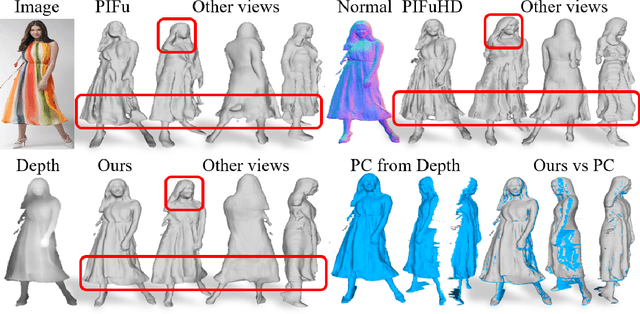
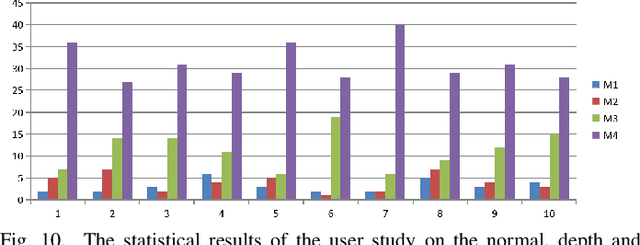
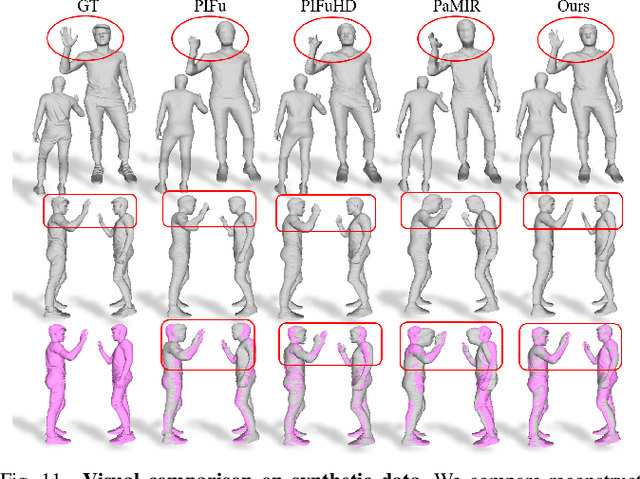

Abstract:It is very challenging to accurately reconstruct sophisticated human geometry caused by various poses and garments from a single image. Recently, works based on pixel-aligned implicit function (PIFu) have made a big step and achieved state-of-the-art fidelity on image-based 3D human digitization. However, the training of PIFu relies heavily on expensive and limited 3D ground truth data (i.e. synthetic data), thus hindering its generalization to more diverse real world images. In this work, we propose an end-to-end self-supervised network named SelfPIFu to utilize abundant and diverse in-the-wild images, resulting in largely improved reconstructions when tested on unconstrained in-the-wild images. At the core of SelfPIFu is the depth-guided volume-/surface-aware signed distance fields (SDF) learning, which enables self-supervised learning of a PIFu without access to GT mesh. The whole framework consists of a normal estimator, a depth estimator, and a SDF-based PIFu and better utilizes extra depth GT during training. Extensive experiments demonstrate the effectiveness of our self-supervised framework and the superiority of using depth as input. On synthetic data, our Intersection-Over-Union (IoU) achieves to 93.5%, 18% higher compared with PIFuHD. For in-the-wild images, we conduct user studies on the reconstructed results, the selection rate of our results is over 68% compared with other state-of-the-art methods.
SimpModeling: Sketching Implicit Field to Guide Mesh Modeling for 3D Animalmorphic Head Design
Aug 05, 2021



Abstract:Head shapes play an important role in 3D character design. In this work, we propose SimpModeling, a novel sketch-based system for helping users, especially amateur users, easily model 3D animalmorphic heads - a prevalent kind of heads in character design. Although sketching provides an easy way to depict desired shapes, it is challenging to infer dense geometric information from sparse line drawings. Recently, deepnet-based approaches have been taken to address this challenge and try to produce rich geometric details from very few strokes. However, while such methods reduce users' workload, they would cause less controllability of target shapes. This is mainly due to the uncertainty of the neural prediction. Our system tackles this issue and provides good controllability from three aspects: 1) we separate coarse shape design and geometric detail specification into two stages and respectively provide different sketching means; 2) in coarse shape designing, sketches are used for both shape inference and geometric constraints to determine global geometry, and in geometric detail crafting, sketches are used for carving surface details; 3) in both stages, we use the advanced implicit-based shape inference methods, which have strong ability to handle the domain gap between freehand sketches and synthetic ones used for training. Experimental results confirm the effectiveness of our method and the usability of our interactive system. We also contribute to a dataset of high-quality 3D animal heads, which are manually created by artists.
Deep Fashion3D: A Dataset and Benchmark for 3D Garment Reconstruction from Single Images
Mar 28, 2020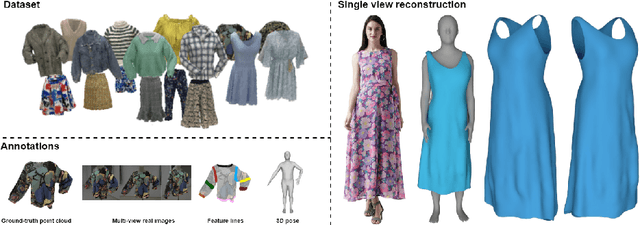

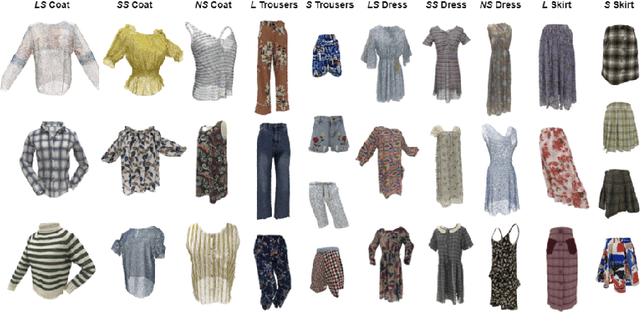
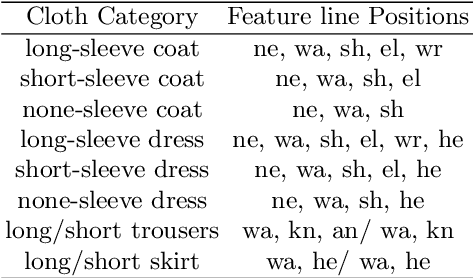
Abstract:High-fidelity clothing reconstruction is the key to achieving photorealism in a wide range of applications including human digitization, virtual try-on, etc. Recent advances in learning-based approaches have accomplished unprecedented accuracy in recovering unclothed human shape and pose from single images, thanks to the availability of powerful statistical models, e.g. SMPL, learned from a large number of body scans. In contrast, modeling and recovering clothed human and 3D garments remains notoriously difficult, mostly due to the lack of large-scale clothing models available for the research community. We propose to fill this gap by introducing Deep Fashion3D, the largest collection to date of 3D garment models, with the goal of establishing a novel benchmark and dataset for the evaluation of image-based garment reconstruction systems. Deep Fashion3D contains 2078 models reconstructed from real garments, which covers 10 different categories and 563 garment instances. It provides rich annotations including 3D feature lines, 3D body pose and the corresponded multi-view real images. In addition, each garment is randomly posed to enhance the variety of real clothing deformations. To demonstrate the advantage of Deep Fashion3D, we propose a novel baseline approach for single-view garment reconstruction, which leverages the merits of both mesh and implicit representations. A novel adaptable template is proposed to enable the learning of all types of clothing in a single network. Extensive experiments have been conducted on the proposed dataset to verify its significance and usefulness. We will make Deep Fashion3D publicly available upon publication.
FPConv: Learning Local Flattening for Point Convolution
Mar 14, 2020



Abstract:We introduce FPConv, a novel surface-style convolution operator designed for 3D point cloud analysis. Unlike previous methods, FPConv doesn't require transforming to intermediate representation like 3D grid or graph and directly works on surface geometry of point cloud. To be more specific, for each point, FPConv performs a local flattening by automatically learning a weight map to softly project surrounding points onto a 2D grid. Regular 2D convolution can thus be applied for efficient feature learning. FPConv can be easily integrated into various network architectures for tasks like 3D object classification and 3D scene segmentation, and achieve comparable performance with existing volumetric-type convolutions. More importantly, our experiments also show that FPConv can be a complementary of volumetric convolutions and jointly training them can further boost overall performance into state-of-the-art results.
Deep Reinforcement Learning of Volume-guided Progressive View Inpainting for 3D Point Scene Completion from a Single Depth Image
Mar 12, 2019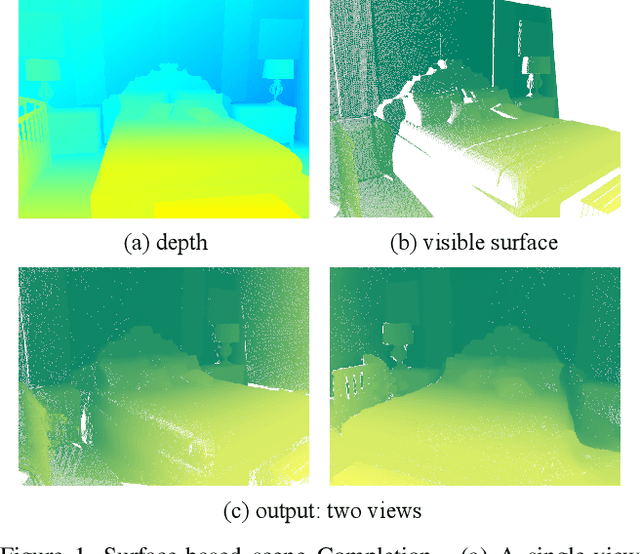



Abstract:We present a deep reinforcement learning method of progressive view inpainting for 3D point scene completion under volume guidance, achieving high-quality scene reconstruction from only a single depth image with severe occlusion. Our approach is end-to-end, consisting of three modules: 3D scene volume reconstruction, 2D depth map inpainting, and multi-view selection for completion. Given a single depth image, our method first goes through the 3D volume branch to obtain a volumetric scene reconstruction as a guide to the next view inpainting step, which attempts to make up the missing information; the third step involves projecting the volume under the same view of the input, concatenating them to complete the current view depth, and integrating all depth into the point cloud. Since the occluded areas are unavailable, we resort to a deep Q-Network to glance around and pick the next best view for large hole completion progressively until a scene is adequately reconstructed while guaranteeing validity. All steps are learned jointly to achieve robust and consistent results. We perform qualitative and quantitative evaluations with extensive experiments on the SUNCG data, obtaining better results than the state of the art.
 Add to Chrome
Add to Chrome Add to Firefox
Add to Firefox Add to Edge
Add to Edge